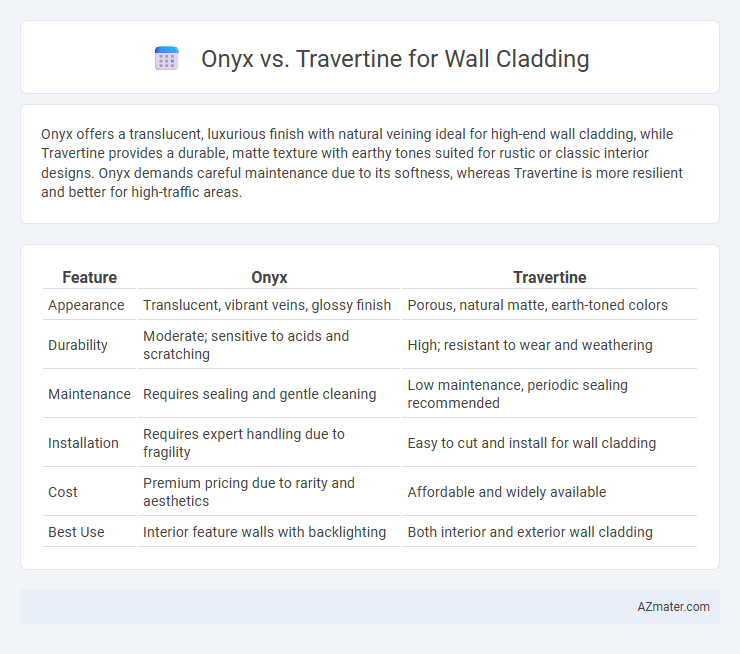Onyx offers a translucent, luxurious finish with natural veining ideal for high-end wall cladding, while Travertine provides a durable, matte texture with earthy tones suited for rustic or classic interior designs. Onyx demands careful maintenance due to its softness, whereas Travertine is more resilient and better for high-traffic areas.
Table of Comparison
| Feature | Onyx | Travertine |
|---|---|---|
| Appearance | Translucent, vibrant veins, glossy finish | Porous, natural matte, earth-toned colors |
| Durability | Moderate; sensitive to acids and scratching | High; resistant to wear and weathering |
| Maintenance | Requires sealing and gentle cleaning | Low maintenance, periodic sealing recommended |
| Installation | Requires expert handling due to fragility | Easy to cut and install for wall cladding |
| Cost | Premium pricing due to rarity and aesthetics | Affordable and widely available |
| Best Use | Interior feature walls with backlighting | Both interior and exterior wall cladding |
Introduction to Onyx and Travertine Wall Cladding
Onyx wall cladding offers a translucent, luxurious appearance with rich veining and vibrant colors, making it ideal for feature walls and high-end interior designs. Travertine wall cladding provides a natural, earthy texture with warm tones and durability, often used in both interior and exterior applications for a timeless, classic look. Both materials are prized in architecture for their unique aesthetic qualities and versatility in enhancing wall surfaces.
Unique Characteristics of Onyx
Onyx showcases a striking translucency and vibrant veining that creates a dramatic, luminous effect ideal for backlit wall cladding. Its delicate composition requires careful sealing and maintenance to preserve its natural beauty and prevent etching or staining. The stone's range of rich colors and intricate patterns offers unparalleled aesthetic appeal, setting it apart from the more porous and matte appearance of travertine.
Distinct Features of Travertine
Travertine, a natural limestone, features a porous, fibrous texture with warm, earthy tones ranging from cream to rusty red, making it ideal for creating a rustic or Mediterranean aesthetic in wall cladding. Its durability and resistance to moisture make travertine suitable for both interior and exterior applications, providing a textured surface that enhances visual depth and natural beauty. Compared to onyx, travertine boasts greater heat resistance and a matte finish, offering a more understated elegance for architectural designs.
Aesthetic Appeal: Colors and Patterns
Onyx wall cladding offers a striking aesthetic appeal characterized by its translucency and vibrant, rich colors ranging from deep amber to emerald green, often enhanced by natural light that highlights its unique veining patterns. Travertine, in contrast, provides a more subdued, earthy palette with warm beige, ivory, and rust tones, featuring porous textures and natural linear veining that create a classic, timeless look. Both materials elevate wall surfaces distinctly, with onyx delivering a bold, luxurious statement and travertine imparting a rustic, elegant charm suited for diverse design styles.
Durability and Longevity Comparison
Onyx, a translucent and softer natural stone, offers unique aesthetic appeal but is less durable and more prone to scratches and acid damage compared to travertine. Travertine, a dense and highly durable limestone, excels in longevity with excellent resistance to weathering and wear, making it ideal for high-traffic and exterior wall cladding. While onyx requires more delicate care and maintenance, travertine's toughness ensures a longer lifespan with minimal upkeep.
Maintenance Requirements for Each Stone
Onyx wall cladding demands careful maintenance due to its high porosity and susceptibility to scratching, requiring regular sealing and gentle cleaning agents to preserve its translucency and prevent staining. Travertine offers more durability with a naturally textured surface that hides wear and requires less frequent sealing, though it still needs prompt cleaning to avoid discoloration from spills. Both stones benefit from avoiding harsh chemicals, but onyx's delicate nature calls for more consistent upkeep to maintain its aesthetic appeal in wall cladding applications.
Cost Analysis: Onyx vs Travertine
Onyx wall cladding typically costs significantly more than travertine due to its rarity, translucency, and labor-intensive extraction process, with prices ranging from $40 to $100 per square foot compared to travertine's $20 to $50 per square foot. Maintenance expenses for onyx are also higher because of its softer composition, which requires specialized cleaning products and more frequent sealing. Travertine offers a more budget-friendly solution with greater durability and lower upkeep costs, making it a practical choice for cost-conscious projects without sacrificing aesthetic appeal.
Installation Process and Challenges
Onyx wall cladding demands meticulous handling due to its fragile and translucent nature, requiring specialized adhesives and backlighting considerations during installation. Travertine, a porous and dense natural stone, poses challenges like sealing requirements to prevent moisture absorption and demands heavy-duty anchoring for secure wall adherence. Both materials necessitate professional installation, but Onyx often involves higher labor costs and longer installation times compared to the more durable and easier-to-handle travertine.
Best Applications and Design Ideas
Onyx offers a translucent quality that makes it ideal for backlit wall cladding, creating a dramatic and luxurious ambiance in spaces like hotel lobbies, high-end retail stores, and upscale bathrooms. Travertine's natural porous texture and warm earth tones are perfect for rustic or Mediterranean-inspired interiors, providing durability and a timeless look suitable for feature walls and fireplace surrounds. Combining onyx and travertine in layered or contrasting patterns enhances visual interest and balances elegance with natural warmth in sophisticated design schemes.
Choosing the Right Stone for Your Wall Cladding
Onyx offers a translucent, luxurious appearance with vibrant veining that enhances interior wall cladding, ideal for accent walls requiring a dramatic visual impact. Travertine provides a more rustic, earthy texture with natural pits and a matte finish, making it suitable for both indoor and outdoor wall cladding with a timeless appeal. Selecting the right stone depends on desired aesthetic, durability, maintenance requirements, and location exposure, with onyx suited for low-traffic, controlled environments and travertine for versatile, high-traffic areas.

Infographic: Onyx vs Travertine for Wall Cladding
 azmater.com
azmater.com